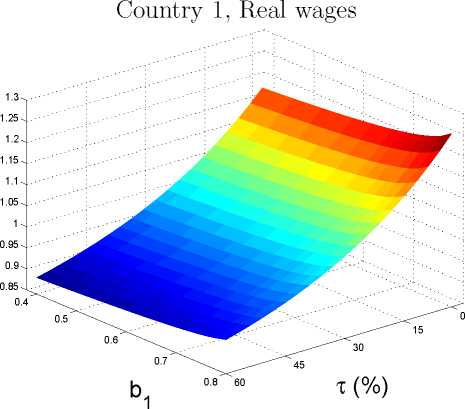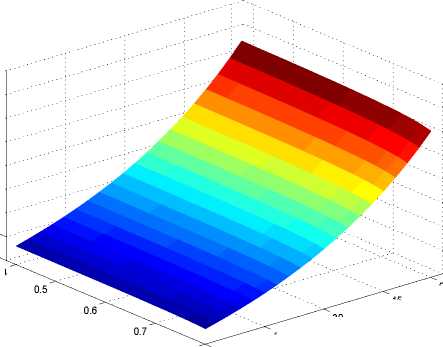
0.4
Country 2, Real wages
1.25-.
1.2-
1.15-
1.1 -
1.05-
1 -
0.95-
0.9
0.85

0
15
30
0.8 60
45
b1
τ (%)
Figure A1: Country 1 labor market regulation, trade costs, and real wages [on vertical
axis] in countries 1 and 2 (=3).
A2 Wage effects
As we have demonstrated in the main text, the magnitude of the spill-over crucially
depends on the level of real wage flexibility. Hence, in parallel to the unemployment
effects described in the main text for the individual-bargaining model, we illustrate in this
Appendix the accompanying results for real wages. Due to the way how unemployment
and wages are determined in the individual-bargaining regime, real wage effects are mainly
mirror images of the unemployment effects: Whenever a policy change in one country
leads to a decrease in average productivity in its trading partners, we will not only see an
increase in unemployment in the trading partners but also a decrease in real wages.
A2.1 How domestic institutions impact outcomes world-wide
Result A1a [Globalization and labor markets]
Trade liberalization leads to higher real wages in all countries.
Result A1b [Labor market reform]
If one country increases its unemployment benefits, then real wages increase in that coun-
try.
Result A1c [Institutional spill-overs]
If one country increases its unemployment benefits, then, in all other countries, real wages
will fall.
For an illustration see Figure A1. Again Result A1a is a generalization of the results
found by Felbermayr, Prat, and Schmerer (2008) for asymmetric countries. Result A1b
stems from the fact that higher unemployment benefits increase the bargaining power of
51
More intriguing information
1. The name is absent2. IMMIGRATION AND AGRICULTURAL LABOR POLICIES
3. Regional differentiation in the Russian federation: A cluster-based typification
4. The name is absent
5. Existentialism: a Philosophy of Hope or Despair?
6. FISCAL CONSOLIDATION AND DECENTRALISATION: A TALE OF TWO TIERS
7. The name is absent
8. Labour Market Flexibility and Regional Unemployment Rate Dynamics: Spain (1980-1995)
9. The constitution and evolution of the stars
10. The ultimate determinants of central bank independence